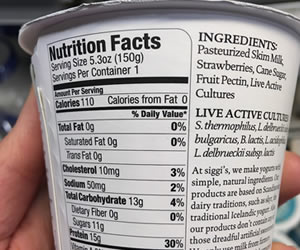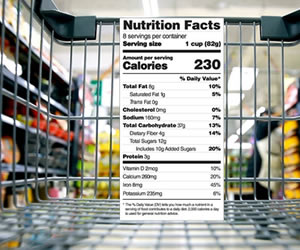 Navigating the grocery store aisles can feel like walking through a maze, especially when trying to make healthy choices. The Nutrition Facts label, found on packaged foods and beverages, is a valuable tool designed to help consumers understand what’s in their food. However, deciphering this information can sometimes seem daunting. Understanding how to read this label is crucial for making informed food choices that contribute to a healthy diet. This blog post will guide you through the six essential steps of reading a Nutrition Facts label, simplifying the process and empowering you to choose healthier options for you and your family.
Navigating the grocery store aisles can feel like walking through a maze, especially when trying to make healthy choices. The Nutrition Facts label, found on packaged foods and beverages, is a valuable tool designed to help consumers understand what’s in their food. However, deciphering this information can sometimes seem daunting. Understanding how to read this label is crucial for making informed food choices that contribute to a healthy diet. This blog post will guide you through the six essential steps of reading a Nutrition Facts label, simplifying the process and empowering you to choose healthier options for you and your family.
Step 1: Understanding Serving Size and Servings Per Container
The first step in reading a Nutrition Facts label is to look at the “Serving Size” and “Servings Per Container.” Serving size reflects the amount of food that is typically consumed in one sitting and is not necessarily a recommendation of how much to eat. It’s crucial to compare the serving size on the label to the amount you actually consume. If you eat double the serving size listed, you’re also doubling the calories, fat, sugar, and other nutrients.
For example, if a bag of chips lists the serving size as 10 chips and you eat 20, you need to account for twice the amount of nutrients and calories. Similarly, “Servings Per Container” tells you how many servings are in the entire package. This information can be particularly helpful for understanding how much of the product you can consume before surpassing nutritional guidelines or personal health goals.
Understanding serving sizes is fundamental because it affects the accuracy of your dietary tracking. Misjudging serving sizes can lead to unintentional overconsumption of calories and nutrients, which might not align with your health objectives. In this section, we’ll explore practical tips for measuring serving sizes accurately and how to adjust your perception of portion sizes to match nutritional reality.
Step 2: Calories and Calories from Fat
Calories provide a measure of how much energy you get from a serving of this food. Understanding your daily calorie needs is essential for managing your weight. The “Calories” line on a Nutrition Facts label indicates the total number of calories in one serving of the product, while “Calories from Fat” has been phased out in recent labeling updates to emphasize the type of fat rather than the amount of fat, as not all fats are created equal. Focus on the total calories per serving and how they fit into your total daily calorie intake.
The type of calories is as important as the amount. For instance, 200 calories from a piece of fruit and the same amount from a candy bar have vastly different nutritional values. The fruit provides vitamins, minerals, and fiber, which are beneficial for your health, whereas the candy bar may offer little more than sugar and saturated fat. This section aims to guide you in understanding how to balance calorie intake with physical activity and nutritional quality to support your health and well-being.
Step 3: Nutrients to Limit
Certain nutrients, such as saturated fat, trans fat, cholesterol, and sodium, should be limited as part of a healthy diet. High intakes of these nutrients can be associated with an increased risk of chronic diseases like heart disease, some cancers, or high blood pressure. The Nutrition Facts label can help you identify foods high in these nutrients that are best consumed in moderation.
- Saturated and Trans Fats: Look for foods with lower percentages of saturated and trans fats to help reduce cholesterol levels and lower your risk of heart disease.
- Cholesterol: Dietary cholesterol can also impact blood cholesterol levels. Limiting foods high in cholesterol is advisable for maintaining heart health.
- Sodium: High sodium intake can increase blood pressure and risk of heart disease and stroke. The label can help you choose products with less sodium.
Making informed choices about these nutrients can significantly impact your health. This section will delve into strategies for identifying and limiting these nutrients in your diet, including reading labels carefully and making healthier food selections.
Step 4: Nutrients to Get More Of
The Nutrition Facts label also highlights nutrients you should get more of, including dietary fiber, vitamins A and C, calcium, and iron. These are essential for good health and can help prevent some health conditions. For instance, dietary fiber can help maintain a healthy digestive system and lower the risk of heart disease. Vitamins A and C, calcium, and iron support various functions from vision and immune health to bone health and oxygen transport.
This section emphasizes the importance of these nutrients, how to identify foods rich in them, and the role they play in a balanced diet. By focusing on foods that are nutrient-dense, you’re more likely to meet your nutritional needs without exceeding your calorie intake.
Step 5: Understanding % Daily Value (%DV)
The “% Daily Value” (%DV) provides a snapshot of the nutrient profile of a food item in the context of a total daily diet. A %DV is based on a daily diet of 2,000 calories, though your needs may be higher or lower depending on your age, gender, weight, and activity level. The %DV helps you determine if a serving of food is high or low in a nutrient and compare food products more easily.
A general guide is that 5% DV or less of a nutrient per serving is considered low, and 20% DV or more is considered high. This section will help you understand how to use %DV to gauge the nutritional value of foods and make comparisons between products, assisting in making healthier choices that align with your dietary goals.
Step 6: Using the Ingredients List and Allergy Information
The ingredients list and allergy information are critical components of the Nutrition Facts label, especially for those with food allergies or sensitivities. Ingredients are listed in descending order by weight, meaning the first ingredient contributes the most to the product and the last ingredient the least. This section can help you identify whole foods versus highly processed ones and detect potential allergens.
Understanding how to read and interpret the ingredients list and allergy information can guide you towards healthier, more natural food choices and ensure safety for those with specific food allergies. This part of the label is a tool for making informed decisions about the foods you consume, contributing to overall dietary health.
Conclusion
Reading a Nutrition Facts label doesn’t have to be complicated. By understanding these six steps, you’re equipped to make healthier food choices that support your dietary needs and goals. Incorporating this knowledge into your shopping routine can lead to better health outcomes and a more balanced diet. Empower yourself with the ability to decipher Nutrition Facts labels and take control of your nutritional intake.





